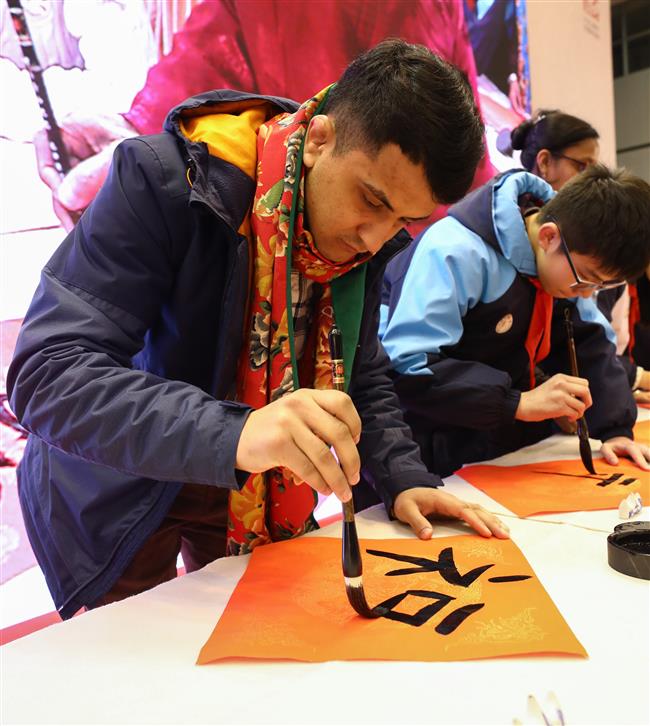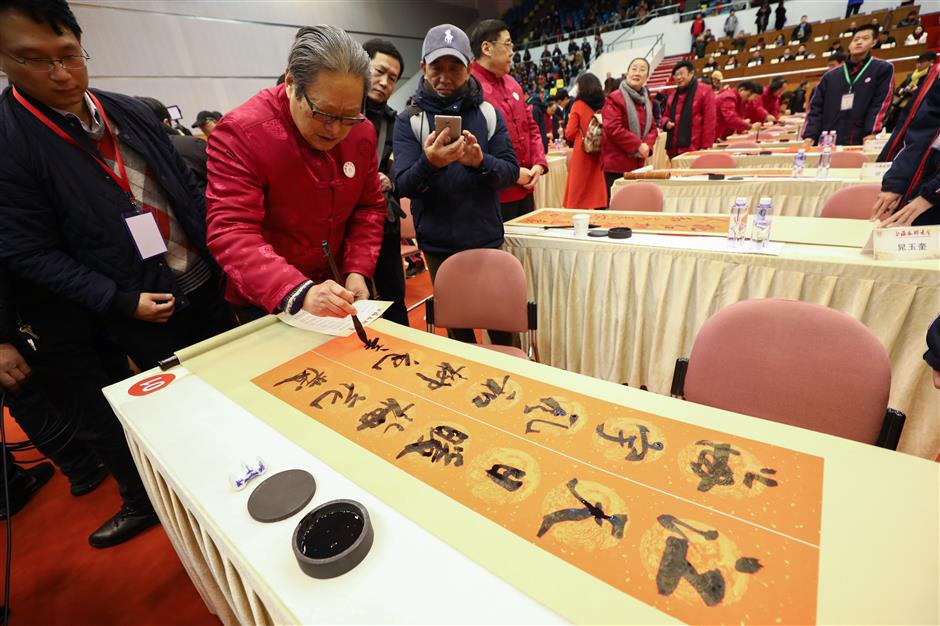Grand calligraphy festival in Shanghai

Rustam, from Tajikistan, writes the Chinese character “fu,” meaning good fortune, in calligraphy at the Spring Festival Couplets event on Sunday at East China Normal University where 100 calligraphers gave artistic expression to the same number of winning couplets that were written at a competition last month.

Calligraphers and foreigners show Spring Festival couplets at the Spring Festival Couplets event. Red couplets are hung on doors during the Chinese New Year.
The first grand Spring Festival couplets show was held in Shanghai on Sunday with 100 calligraphers coming together to give artistic expression to rhyming words.
The couplets were written by winners of a competition that was held last month. The calligraphers used their brushes to write them down on red papers at an event held at East China Normal University.
The organizers had received more than 5,000 couplets and 100 were judged as the best, including entries from nine students from four schools.
Some of the couplets were given to 10 Magnolia award-winning foreigners, 10 labor models and 10 to representatives of migrant workers for their contribution to the city.
Noyan Rona from Turkey, a Magnolia award winner and an honorary citizen of Shanghai where he has lived for 35 years, said he was glad to receive the Spring Festival couplet.
"The calligraphy is very nice and the meaning is very good," he said, adding that he would put it on his door to welcome the new year.
Karina Morales-Herrera, Consul General of Ecuador in Shanghai, also attended the event with her husband and son.
"We love the event because we love Chinese culture," she said. "We enjoyed the happiness of the celebration. Everything is in red."
The event was organized as part of the city’s celebration for the coming Chinese New Year by the Shanghai Federation of Literary and Art Circles, the Shanghai Calligrapher Association, Shanghai Couplet Association and a few local government departments.
Spring Festival is the most important festival in China and people traditionally hang red couplets on the door as a means of expression for the coming year.

A calligrapher writes a couplet.
The art of writing couplets originated in the Song Dynasty (960-1279) and flourished in the Ming Dynasty (1368-1644). Couplet is a pair of neat antithesis writings with equal number of words and is usually combined with calligraphy and literature. It’s also known as “door couplet” and “Spring Festival couplet” as it's usually hung on doors during the Spring Festival.
Organizers hoped that the event would help in promoting traditional Chinese culture among foreigners and popularize the art of couplet writing among the public.
"Though Chinese people still use couplets today, very few people know the details of the tradition," Yang Xianguo, director of the Shanghai Couplet Association, told Shanghai Daily. "Few people know that couplets has some basic rules. Some people don't even know the right way to hang them."
Yang said the first part of the couplet is on the right side and the second part on the left. It is sometimes accompanied by a scroll on top of the gate, but many people still get it wrong.
People are sometimes confused which one is the first part of a couplet.
"The last word of the first part is in third or fourth tone, while the second half ends in first or second tone in Chinese," Yang said.
Yang said it was a good time to promote couplets as the government has been attaching great importance to traditional culture and hoped couplets could become a part of people's lives.















